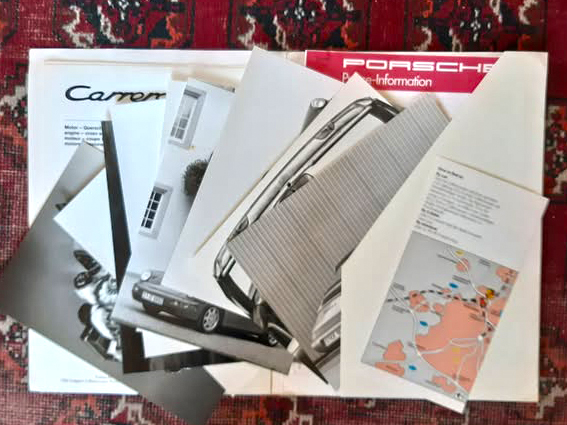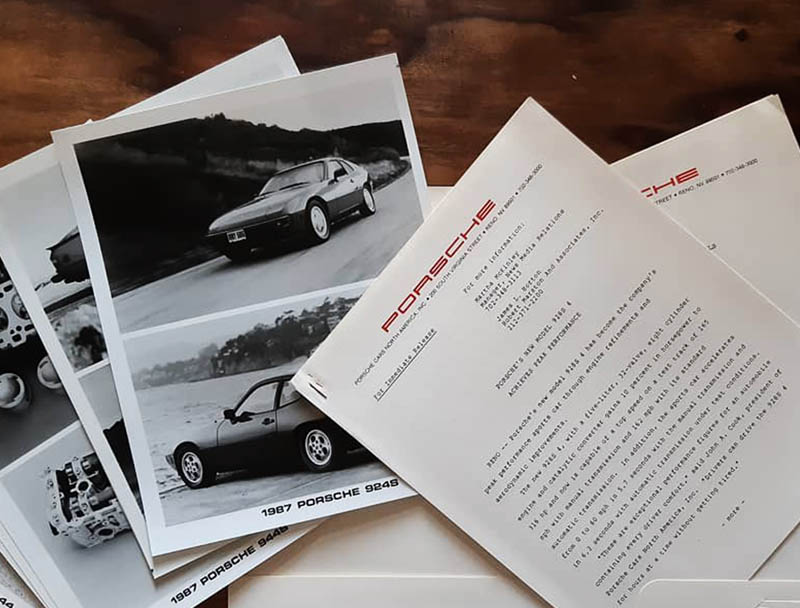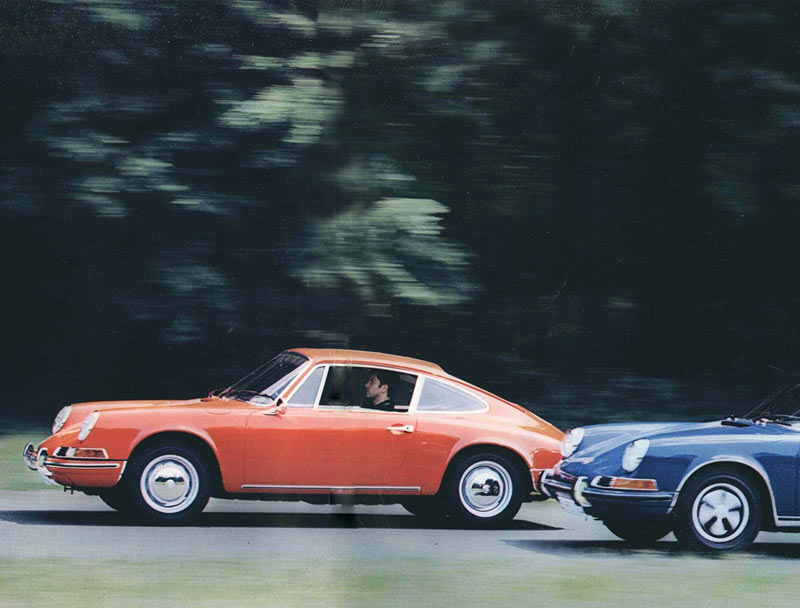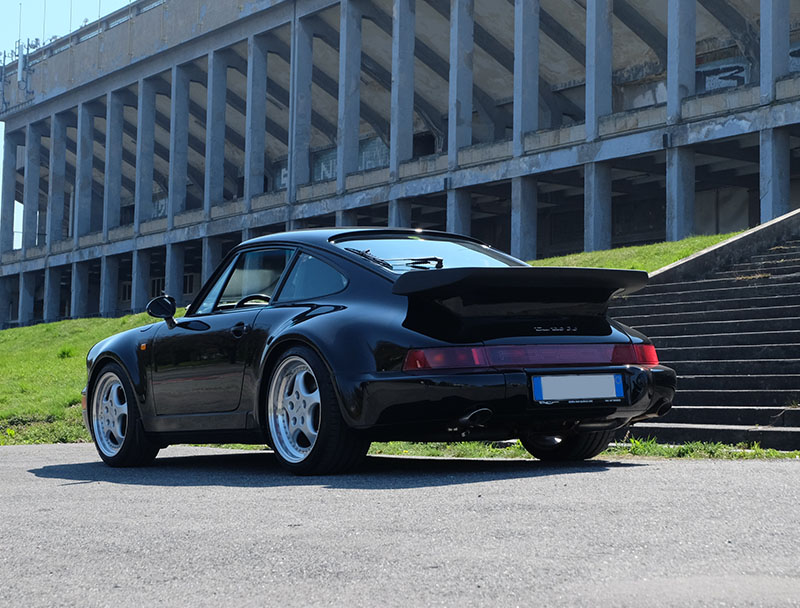.jpg)
1989 - 911 Carrera 4

The 911 Series that has come to be known as the epitomy of the classic Porsche sportscar design has reached a new stage of evolution for the '90s. As the successor to the 911 Carrera, the Carrera 2 will continue to represent the rear-engine, rear-wheel-drive concept that has been made famous by the 356 model. The new, well-insulated 3,6- litre flat-six (184 kW/250 bhp, equipped with catalytic converter as standard equipment) combines characteristic 911 tractability with supreme performance. The new Porsche Tiptronic that was designed especially for the 911 Carrera 2 opens up new dimensions in 91l motoring This automatic transmission with manual gearshift option and control adapted to the driving style is offered as an optional alternative to the five-speed manual transmission.
.jpg)
The Carrera 2 that forms the centerpiece of the Porsche range was redesigned completely along with the 4WD Carrera 4 introduced for the 1989 Model Year: approx. 85 percent of all components are new, including engine, powertrain, suspension, power-assisted steering, ABS braking system, floorpan and the aerodynamically optimized bodyshell that remains completely lift-free. The basic classic body style as well as certain interior elements were retained. The experience gained from the technologically advanced features of the Porsche 959 was put to good use in this sophisticated design.
.jpg)
The new Tiptronic developed by Porsche is the first automatic transmission that has been tailored to suit the characteristics of the 911 as well as the special fascination of driving a 911. The gearshift technology of the Porsche Tiptronic relies on the experience gained with the Porsche dual-clutch transmission (PDK) used in the successful 962 C competition model. In the Porsche Tiptronic, the racecar-proven rocker shift switch combines with an automatic four-speed torque-converter powershift transmission that offers the driver an unprecedented level of control. Manual gearshifts made by slightly actuating the rocker require only a fraction of the time needed for declutching and gearshifting with conventional manual gearboxes. In the fully-automatic mode, the "adaptive program control" of the Tiptronic senses the way the car is driven. This avoids the drawbacks usually found with automatic gearboxes, in particular the unwanted upshifts when cornering, and provides for optimum adaptation to the driving conditions. Since the accelerator position is continuously fed into the control parameters maximum fuel economy can be achieved. As all shifting operations are carried out under load, loss of traction, as would be the case when declutching a conventional manual gearbox, is avoided even when the transmission is operated manually.
.jpg)
The advanced body manufacturing processes launched at the Stuttgart-Zuffenhausen plant for the Carrera 4 have now been extended to incorporate the Carrera 2 and 4 versions including all Coupé, Targa and Cabriolet models (with electronic top operation). Even at its launch, the entire first year's production of the Carrera 4 had already been sold - and, although full use is being made of production capacity, considerable delivery lead times for the Carrera 2 have proved to be unavoidable. Extra shifts are being run to keep those delays down to a level acceptable to the customer.
.jpg)
The 911 Carrera 2 incorporates all the innovative features introduced for the Carrera 4, with the exception of the electronically-controlled four-wheel drive with dynamic biasing of the influences affecting the driveline on the front and rear axles. The carrera 2 retains the rear-engine, rear-wheel drive layout and is the direct offspring of the familiar 911 series. The new suspension design incorporating power-assisted steering and rear- axle toe-angle correction as well as the lift-free bodyshell has enhanced the handling of the Carrera 2 vis-à-vis its Carrera predecessor launched in 1983 Considerably less effort is required to control the vehicle and this in turn enhances its sporting Yet safety-oriented driveability. The apperance and emotive sound of the engine, combined with superior traction of the rear-wheel drive unit, reflect the unmistakeable "911 pedigree" of the Carrera 2.
.jpg)
The axle geometry of the front suspension featuring wishbones and McPherson struts has been modified (nega- tive kingpin offset) and combines with the power-steering unit to improve the steering characteristics dramatically: The influence of road bumps that can always be felt in conventional fully-mechanical steering units has been eliminated to allow the driver to sense the forces present during cornering that are due to lateral acceleration so he is able to control them precisely with a minimum of operating effort required. When driving at high speed along a straight stretch of the Autobahn, the interference due to the road surface and crosswinds can be compensated easily thanks to the new layout of steering, suspension and aerodynamics.
.jpg)
A major contributing factor is the new rear suspension: The inner semi-trailing arms that help to correct the toe-in when lateral forces are present enhance driving stability both when driving along a straight stretch of road and during load changes when cornering. The Carrera joins its predecessor in providing an unparalleled sports car suspension that features precise road control, firm suspension and wheel and tyre sizes tailored to suit the driving dynamics. Thus it allows for high lateral acceleration when cornering and provides maximum steering precision. The easily controlled cornering behavior near the limits constitutes another step ahead in suspension design. The excellent response of the springs combines with the taut damping characteristics to provide optimum driving comfort and reliable grip, even on bumpy road surfaces. Thanks to the ABS system that now comes as standard equipment, full advantage may now be taken of the superior braking deceleration, even under difficult conditions.
The sleek-profiled aluminium wheel discs with large apertures for brake cooling are cast in size 6 (front) and 8 x l6 inch (rear). The Carrera 2 is available exclusively with this wheel type that has been adapted to suit the aerodynamics of the body as well as the mounting space required for the ABS.
.jpg)
In the fully-automatic mode, the selector positions do not differ from those of a conventional automatic unit The difference is in the layout of the shifting program: normally only one or maybe two programs - a "sporting" and an "economy" version - are available. The Tiptronic however, incorporates an "adaptive control" that adapts to the style of driving so that the driver only needs a minimum of time to get used to modifying the switching operations as desired via the accelerator. The usual options of downshifting by accelerating and of upshifting by decelerating are complemented here by a multitude of intermediate steps depending on the way the car is driven. To name an example, decelerating slowly after accelerating results in an upshift; when releasing the accelerator abruptly, however, the previously engaged gear remains engaged. This avoids undesirable upshifts before entering a corner. The torque converter is locked-up in second, third and fourth gear above a certain speed so the engine speed is not raised when the accelerator pedal is depressed. Driving with adaptive control is a new driving experience that can be attributed to the selection and design of the individual parameters. A decisive factor is that the driver is able to make an active contribution even if fully-automatic operation has been selected.
The lever may be moved from the D position to the right into the manual control plane if the driver wishes to control all shift operations manually. To shift up, the switch is dipped forward; to shift down, it is dipped back. The gear selected is displayed on the instrument panel. The shift operation is executed immediately - unless the maximum admissible engine speed would be exceeded by staying in a lower gear when accelerating or by shifting down too soon. In this case, an automatic upshift is made or the downshift is delayed, as appropriate. If the driver brakes to a standstill with third or fourth gear still engaged, the transmission shifts down automatically into second gear even in manual mode since second gear may also be used for accelerating from a rest in conjunction with the torque converter. To provide maximum acceleration first gear may be selected for pulling away. In second gear, the torque converter is locked-up from approx. 40 mph; in third and fourth gear this lockup function is always-operative in manual mode.
.jpg)
Experience has shown that even die-hard 911 drivers prefer the fully-automatic mode in congested traffic situations. For sporting motoring on winding roads, the rocker switch becomes an attractive feature since it puts the gear required "right at your fingertips". The fully-automatic mode,. however, also retains a "911-like" feel since it also provides instant response and adapts itself to the way the car is driven. Many Porsche engineers feel that the considerably faster gearshift operations of the Tiptronic will actually make this the transmission technology of tomorrow.
The decision between Tiptronic and five-speed transmission may not only be based on the question of power shifting but also on personal preferences on gear ratios. Fuel economy differences between the Tiptronic and manual transmissions are minimal. Extremely economy-oriented driving at low engine speeds will give better fuel economy with the manual gearbox than with the Tiptronic; under normal circumstances, however, the adaptive control that shifts according to pre-set parameters is superior to the driver who tends to select gears as he feels fit. Past experience has shown that there is no doubt about the fact that the Tiptronic provides at least as much driving pleasure as the manual transmission. As for its ease of operation and reduced wear of the components, it certainly has the edge over conventional clutch and gear-lever layouts.
.jpg)
The new double-ignition engine with 3.6 litre displacement and a maximum output of 250 bhp (184 kW) at 6,100 rpm is the most powerful naturally-aspirated engine ever fitted into a production 911 model; at the same time, it constitutes an advanced new concept of the classic six-cylinder horizontally-opposed engine: part of the engine is encapsulated to reduce engine noise both inside the passenger compartment and outside the vehicle. The engine comes with a catalytic converter as standard equipment for all countries using unleaded fuel. The version without a catalytic converter that is only supplied in exceptional cases has the same output.
.jpg)
The supreme performance figures of the Carrera 2 are characterized by this rear-wheel drive unit: low- vibration running and a low noise level emphasise the distinctive exhaust note and the instantaneous pull-away capability of the air-cooled flat-six that is available at all speeds. The torque level of 310 Nm that is available from 4800 rpm and the acceleration and top- speed figures are indicative of the superior tractability and performance of the Carrera 2. The distinctive style of new the Carrera 2 vis-à-vis the four-wheel drive Carrera 4 and its Carrera predecessor can only be appreciated by actually driving the vehicle.
.jpg)
The double ignition of the new 911 engine generation has been inspired by Porsche aircraft engine technology. It helps to provide cleaner and more efficient combustion as does the knock control that reduces the fuel octane sensitiveness of the engine to the point where refueling with fuels of an octane rating below the recommended figures will not cause any harm. Ignition and injection are controlled electronically by the Motronic system This combination of high performance and catalytic converter technology is the basis for the development of a new exhaust system with newly-designed heat exchangers that help to supply the heating system with instant hot air that is even available soon after cold starts.
The partial encapsulation of the space-saving horizontally-opposed engine does not change its characteristic "sound". At the same time, the smooth panelling improves the aerodynamics of the floorpan During spells of bad weather, it also helps to keep the engine as clean as on the day it left the factory: The new Carrera thus comes with one of the best soil-proof engine compartments ever designed. The new spoiler design on top of the engine bay keeps up a supply of intake and cooling air that will remain clean, even under adverse conditions, thus protecting the engine.
.jpg)
The body-in-white shell of Carrera 2 and 4 produced in the new Stuttgart-Zuffenhausen body plant is an all-new design that meets the highest requirements for rigitiy and accident protection. Hot-dip galvanized steel used for the complete bodyshell as well as a meticulous production process make the Porsche 911 one of the world's most durable motor cars. This is one of the reasons behind the consistently high resale values of the 911 - even for models that are several years old. This applies both to the Coupé and to the Cabrio and Targa open-top versions. All versions of the Carrera 2 and 4 are based on the same basic bodyshell. The Cabriolet is supplied exclusively with the proven electric soft-top operating mechanism.
The new features of the classic 911 bodyline already introduced for the Carrera 4 have been made possible by aerodynamic optimization. The contours of the vehicle are accentuated by the spoiler bumpers made of shock- absorbing plastics. These moulded parts consist of several replaceable elements which are color-coded to provide a uniform appearance and incorporate the fog lights. Similarly, the rear fog lights have been incorporated into the rear panels. The shape of the classic round headlights at the front remains unchanged; the rear light cluster has been inclined.
.jpg)
On the subject of aerodynamics of the 911, lift is just as important as drag. Reducing lift via the use of front and rear spoilers as well as special modifications to the underbody is of paramount importance to road safety at high speeds. The drag coefficent (CD) of the Carrera 2 and 4 has been reduced from 0.395 to 0.32. This has been achieved by numerous new bodywork features, including the flush-mounted windscreen and the drip rail mating up with the A-post as well as the underbody panels that incorpo- rate the engine encapsulation and the exhaust system to provide a smooth underbody structure right back to the tail end. By foregoing an even better cd value we were able to reduce the lift coefficient (cL) to a figure near to zero. The limited cross-sectional area allows for a low overall drag coefficient which in combination with zero lift shows the superior aerodynamic properties of the Carrera 2. This is an essential prerequisite for high fuel economy.
While the rear spoilers on previous models changed the contours of the 911 and were thus only mounted as optional equipment, the retractable rear spoiler now fitted to the Carrera 2 and 4 comes as standard equipment. The aim behind this new design was to retain the classic rear lines of the 911 while at the same time ensuring optimum flow conditions and keeping the engine intake air clean. With this solution, a part of the exisiting engine hood is raised so it does not require any additional components. This helps to almost double the cross-sectional area of the cooling air intake. The spoiler is raised automatically at 80 km/h (50 mph) via electromotors and is retracted at 10 km/h (6 mph). This ensures that the spoiler is always raised at high speeds yet unnecessarily frequent raising and retracting operations at lower and medium speeds are avoided Porsche pioneered the introduction of the additional front and rear spoilers commonly encountered on today's cars. The retractable spoiler underlines the functional properties of those aerodynamical negative lift aids that were never used by Porsche exclusively for their visual and fashionable appeal.
.jpg)
Interior and instrument cluster design retains the typical 911 layout, yet numerous practical improvements have been incorporated. The level of output air and temperature consistency of the fully-automatically controlled heating and ventilation system have never before been achieved for an air-cooled engine. An air conditioning system available as an option provides various combinations of fresh and recirculating air. Its controls are placed conveniently on the dashboard. The round instruments feature backlight technology; symbols and logos only become visible when they are needed to supply the driver with vital information. Shift lever center console and tray panel are of an enhanced ergonomic design and the light switch (formerly a pull- switch) has now been redesigned as a rotary switch to standardize it on all models.
The layout of the front luggage compartment has also been changed. It can still accommodate several smaller bags or one normally-sized hard-case suitcase. The Carrera 2. along with the Carrera 4, is one of only a few sports cars that do not only feature reclining back seats but also an additional, separate luggage compartment. By adjusting the driver's and passenger's seats accordingly (electrical height and inclination adjustment as well as mechanical fore- and aft-adjustment are standard), two adults can still be seated comfortably in the rear. The Carrera thus represents the classic "Gran Turismo" layout that had already been seen with the 356 - a personal allround sports car for optimum driving pleasure.
.jpg)
.jpg)
1989 - 911 Carrera 4
.jpg)
1990 - Carrera 2 Cup

Porsche Press kit

Porsche Literature

Our Porsche Cars